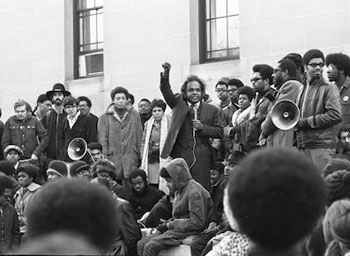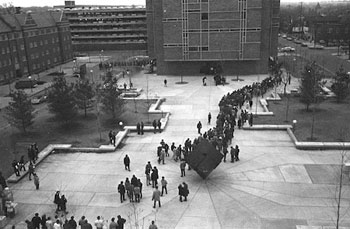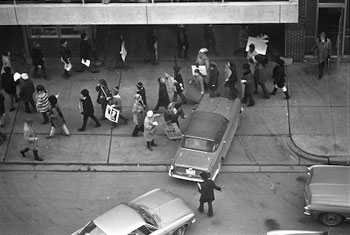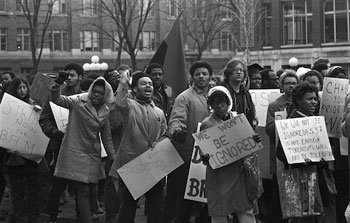“Open It Up or Shut It Down”
It’s a warm, breezy afternoon in late March. On the University of Michigan’s Diag – a grassy square in the center of campus crisscrossed by sidewalks – students are tossing Frisbees, strumming guitars, basking in the sun, and generally enjoying the promise of spring after a long, cold winter. The clothes and hairstyles change, but for the most part the scene remains the same, year after year.

Black Action Movement protesters on the University of Michigan campus in 1970. (Photo courtesy of Jay Cassidy.)
Except that if you could somehow step back in time exactly four decades you would be greeted by a very different sight: students shouting, marching, and picketing; classes disrupted, canceled, or being held in nearby churches; angry voices calling for the deployment of the National Guard; a campus and community pushed almost to the breaking point. If the events of the Black Action Movement strike of 40 years ago had unfolded only a little differently, today people might speak of “Michigan” rather than “Kent State” as marking the tragic and deadly end of the sixties.
Instead, the BAM strike became one of the few protests of that era in which the students could make a valid claim of victory.
As it turned out, each side would have reason to believe that it had bested the other. The students because the university had been forced to negotiate and had ultimately acceded to the most important of their demands; the university administration because they claimed to be merely going forward with the plan they had proposed at the outset, rather than succumbing to student pressure.
That the protest came to a peaceful conclusion was due most probably to the restraint exhibited by university president Robben Fleming, and perhaps moreover Gov. William Milliken, who unlike other state leaders of that time (primarily Ronald Reagan in California) was not inclined to ruthlessly crush student rebellions; as well as the BAM leadership, who despite their often inflammatory rhetoric were determined to keep the strike non-violent.
The programs instituted as a result of the BAM strike of 1970 represented the first major breakthrough in a decades-long struggle to end discrimination at the University of Michigan. Up until the 1960s there were few black students or faculty at the university. In 1962 a federal investigation concluded that there was considerable racial bias in hiring at UM and urged that steps be taken to increase integration at every level. A committee set up by President Harlan Hatcher recommended that a special program be established to provide additional recruiting of minority students as well as financial aid and support services. The Opportunity Awards Program was started in 1964 and by 1969 black enrollment had increased from 2% to a little over 3%.
To many, however, this modest increase hardly seemed to make a difference. Elise Bryant was a freshman at the university in the fall of 1969. Coming from a mostly black neighborhood in Detroit, she was struck by the scarcity of African-Americans on campus. “You wouldn’t see any black people on the street,” she recalls, “and it became this custom that if you saw a black person on the street you would say, ‘What’s happening?’ And I remember when I would leave Ann Arbor and go to New York for a visit, or go back to Detroit, I’d start talking to every black person on the street, and it wasn’t the same. Sometimes there were weird reactions. People were like, ‘What are you talking to me for?’”
Once accepted at the university, black students continued to face prejudice and discrimination that was deeply entrenched in campus life. “It was that Northern brand of racism that was more subtle, that wasn’t blatant” explains Bryant. “I mean, all my friends were getting jobs as waitresses, and I applied to every restaurant on campus as a waitress and couldn’t get hired.”
Cynthia Stephens, a bright young African-American student who came to Ann Arbor in the fall of 1968 at age 16, remembers being told by her adviser to take a reduced course load. “I’m sitting there staring at her in amazement. I wasn’t Suma Cum Laude from Cass, but I had a 1300 SAT score, which qualified me in those days to make my own schedule without going to a counselor. And I was just like, ‘Are you looking at my record, or looking at me?’”
In the spring of 1968, following the assassination of Dr. Martin Luther King, Jr., a group of black students locked themselves into the UM administration building to protest the lack of support for minorities at the university. In response, the administration agreed to establish a Martin Luther King scholarship fund and appoint a few additional black administrators. Over the next year President Fleming (who replaced the retiring Harlan Hatcher) held discussions with black students that resulted in the establishment of a Black Studies curriculum and the opening of the Center for Afro-American Studies in the fall of 1969.

A Black Action Movement protest outside the Frieze Building in 1970. (Photo courtesy of Jay Cassidy.)
But for many, the integration of the university was simply not moving fast enough. In late 1969 representatives of most of the black student groups on campus came together and decided that a more proactive approach would be required in order to speed the process. The following January a series of talks were held between black students and university administrators regarding the matter of black enrollment, and a number of the students were invited to dine with President Fleming and further discuss the issues.
When the students arrived at the president’s house on the evening of Feb. 5, however, it wasn’t to have dinner but rather to hold a demonstration on the front lawn in which they presented Fleming with a list of demands. Chief among these was an increase in black enrollment to 10% – the percentage of the state population that was African-American – by the fall of 1973. Other demands included the hiring of additional recruiters for black students, the hiring of additional black faculty, the institution of new support services for black students, the establishment of a Black Student Center, the expansion of the MLK scholarship fund, tuition wavers for disadvantaged students, and a significant increase in the almost non-existent Hispanic student population.
“We do not expect the university to procrastinate and sub-committee these demands,” the statement concluded. “They are for immediate and positive action.” It was signed by “the United Black Population at the University of Michigan,” a coalition of a half dozen or so black groups from the various colleges and departments of the university. Soon they would adopt the much catchier moniker of the Black Action Movement, and bring the university as close to calamity as it would ever be during the entire period of student protest.

University of Michigan President Robben Fleming at a news conference during the 1970 Black Action Movement strike. (Photo courtesy of Jay Cassidy.)
The atmosphere was tense at the regents’ meeting on Feb. 19, when representatives of BAM appeared to present their demands in person. Although tempers occasionally flared, most of the regents expressed sympathy with BAM’s position. They refused to respond directly to the demands, however, and asked President Fleming to prepare an alternative proposal for their next public meeting in March. BAM stormed out of the room and a group of about 25 black students went to the Undergraduate Library and took hundreds of books off the shelves, forcing the building to close while the books were replaced.
The next morning BAM members gathered at the university’s administration building to again demand immediate action. When President Fleming and the regents once more refused, a larger contingent of black students went back to the library and disarranged thousands more books. Fleming responded by stationing Ann Arbor police officers at major university libraries.
In the coming weeks there were further disruptions, such as the interruption of classes to discuss the BAM demands, and the blockading of the Michigan Union snack bar. These actions were upsetting to many, but even so support for the BAM position was growing across campus.
Early in March President Fleming made a public announcement of his alternative proposal. It established 10% black enrollment as a “goal” rather than a commitment, and promised that the university would work toward achieving a number of the other BAM dictates, but only if additional funding could be found. Fleming contended in his 1996 memoir, “Tempests into Rainbows,” that it was primarily lack of funding that prevented the university from granting the BAM demands.
The regents held an open meeting on March 18 to discuss Fleming’s plan. Almost 500 people attended. An exhausting and at times heated debate – in which BAM referred to the administration’s proposal as a “nebulous, weasel-worded proposition” – ended without agreement. The BAM leaders called for a demonstration in nearby Regents Plaza the next day.

Protesters in 1970 marching across the University of Michigan Regents Plaza. (Photo courtesy of Jay Cassidy.)
On March 19, 1970, while inside the administration building the regents voted their approval of Fleming’s plan, outside was an angry rally in which the BAM leadership announced that the university’s black students were on strike and intended to close down the campus until their demands were met. Police were summoned and the gathering became a melee, with scuffles breaking out between law officers and demonstrators. Four students were arrested. Charges of racism were made against the Ann Arbor police because although a good proportion of the demonstrators were white, all of the arrestees were black.
The presence of significant numbers of white students at the March 19 demonstration underscores an important aspect of the BAM strike: the support it was given by the traditionally non-black activist groups on campus, such as Students for a Democratic Society. The participation of white students was crucial to the effectiveness of the strike, if for no other reason than there simply were not enough African-Americans on campus to be able to make a significant impact on the normal operations of the university.
On March 20 a group of about 200 picketers marched outside Hill Auditorium during the university’s Honors Convocation, at which President Robben Fleming was speaking. A party of white protesters entered the concert hall and marched up and down the aisles, fists raised in a Black Power salute, chanting “Open it up or shut it down.” BAM leaders were angry that the disruption of the ceremony had been undertaken without their approval. Through the Michigan Daily, the university’s student newspaper, BAM told its supporters: “If we don’t say do something, don’t you do it.”

Protesters at Hill Auditorium during a University of Michigan Honors Convocation. (Photo courtesy of Jay Cassidy.)
Not everyone in BAM was in favor of accepting help from white activists. But it was eventually agreed that the non-black groups would be welcome as long as they remained in a subordinate role. Cynthia Stephens, who had become a leading figure in BAM – “I was the vice president, because in those days that was what women were” – recalls that many were worried that the white radicals, who were more experienced in managing protests, might try to take over. “In order for the strike to have been successful, whether we perceived it or not, we needed their support,” says Stephens. “But it needed to be support.”
Madison Foster, who was a junior faculty member and one of the leaders of the BAM negotiating team, thinks that to focus on the ethnicity of the strikers is to cloud the most important aspect of the protest. “It wasn’t just a black strike, or a white strike,” he says. “It was a student strike.”
By the following Monday, March 23, the moratorium was having a clear impact – to the surprise of almost everyone, including BAM itself. Picketers marched outside the main classroom buildings and class attendance was noticeably down. A number of professors and teaching fellows joined the strike and canceled their classes, while others held their classes off campus to show support.
The university presented a front of indifference. The Michigan Daily quoted one regent as saying, “The students can strike until hell freezes over as far as I am concerned.” President Fleming added, “As long as classes are being held, we don’t have to care whether people are going or not.”

Picketers block access to a university parking structure during the 1970 Black Action Movement strike. (Photo courtesy of Jay Cassidy.)
This outlook would change as the week wore on and the strike gathered momentum. Class attendance continued to drop. The School of Social Work, the Residential College, and the Institute for Social Research closed down. BAM and its supporters instigated additional disruptions, interrupting classes to talk about the issue of the strike, marching through hallways banging on trash cans, picketing in front of parking garages, and blocking traffic (someone “lost” a contact lens in the middle of State Street by the Michigan Union and a group of strikers spent an hour on their knees looking for it).
By Wednesday, attendance at the College of Literature, Science and the Arts (LSA) was down an estimated 60%. More and more faculty were coming out in favor of the BAM position, and President Fleming offered to meet with black leaders at the bargaining table. BAM was feeling its power, however, and was not so inclined to make a quick settlement. By Thursday, LSA attendance was down an estimated 75% and the college was considering shutting its doors.
Then on Friday came what may have been the most crucial development, when the American Federation of State and County Municipal Employees announced its support of the strike. University employees who were AFSCME members refused to cross the student picket lines and campus food service came to a grinding halt. “The men and women of AFSCME were incredible,” remembers Cynthia Stephens, now a judge on the Michigan Court of Appeals. “It’s what made me initially decide I really, really, really wanted to be a labor lawyer.”
Elise Bryant concurs. “In my mind it was the union that made us strong. Because I think the administration would’ve let us spin our wheels until the end of the semester, then wait for the next crop of students to come in. Which is what they figured out after that – give them what they want and then they’ll be gone.”
Toward the end of the week the strike increased in intensity, with the disruptions taking on a more physical nature. Windows were being broken and other university property damaged. Some faculty and students were feeling threatened. But neither BAM nor President Fleming wanted violence, and both made great efforts to keep the situation under control.

Black Action Movement protesters on the University of Michigan campus in 1970. (Photo courtesy of Jay Cassidy.)
“We used conflict,” explains Madison Foster, “but we kept some of the hotheads from doing violent things, both black and white. We had to tighten up some people so they understood that there were consequences, if they were talking about blowing up something or doing something destructive, because we would end up being the ones that would be hurt.”
President Fleming was also under increasing pressure to bring the strike to an end, by force if necessary. “I credit Fleming for not escalating the conflict by calling in troopers, or by escalating his rhetoric,” Foster says. “In that sense he handled the situation well.”
But what is not generally known is that at an early point in the negotiations, Fleming – whose reputation as a leader at both the University of Wisconsin and UM rests to a large extent on his disinclination to use force to end student disruptions – threatened to bring in the military. “To me that was a very critical point,” says Foster. “Early on, after maybe the third session, he said flatly that if we didn’t abandon the buildings and do the things he wanted, he was going to call the National Guard. I was telling a friend that I probably made one of the boldest comments of my life, in hindsight. I said, ‘Well, I guess we’ll die,’ and we walked out. I wasn’t going to negotiate under threat.”
Foster’s recollections take on added significance when one considers that a little over a month following the resolution of the BAM strike, 13 student protesters were shot and four killed by National Guardsmen at Kent State University in Ohio, less than a day’s drive from Ann Arbor. Tensions were running high on the Michigan campus, and all across the country that spring. If the military had been called out to end the BAM strike, the results could have been tragic. Thankfully, they were not.
“We didn’t realize that people would really ever shoot at students,” says Cynthia Stephens. “It wasn’t real to us. If we had tried to start the BAM strike after Kent State, I don’t know if it would’ve happened. I also sort of wondered whether – and I don’t know this at all, because I didn’t know folk at Kent State – I wondered whether the measured response by the University of Michigan gave encouragement to the students at Kent State to believe that what happened there wouldn’t happen.”
Negotiations continued over the weekend but on Monday, March 30, the strike began to lose momentum. Class attendance was on the rise and food service had resumed. Some may have believed the strike to be over after the university announced on Sunday that agreement had been reached on nearly all points, despite an informal arrangement between BAM and the president that neither side would make public statements until the negotiations were completed. (Fleming claimed that the press release was a mistake, but it could also have been a canny political maneuver.)
Money had been found in the various colleges and departments of the university to support the desired increase in black enrollment, as well as many of BAM’s other demands. The only major point of disagreement remaining was whether 10% enrollment should be a “commitment” or a “goal.” The BAM leadership decided that it was time to settle.
“I think we reached a point where we believed we had gotten what we could get,” explains Cynthia Stephens. “We had achieved maximum victory from that event, and this wasn’t a winner-take-all contest.” Also, the students were becoming restless, she says. “It was getting to the end of the semester. They needed to graduate and finish classes.”
“And ultimately, how long we could keep external forces away” – i.e., the National Guard – “was also an issue.”
On April 1, 1970, it was announced that a settlement had been reached and the strike was over. The university pledged several million dollars toward the “goal” of reaching 10% black enrollment by the 1973-74 term. Programs would be established to recruit black students and faculty, aid and support services would be put in place for minority students, and the Center for Afro-American Studies would receive increased funding. However, there would be no Black Student Center, no tuition wavers, nor any additional funding for the MLK scholarship. Also refused was amnesty for students who would otherwise be disciplined for their actions during the strike.
BAM leaders staged a victory celebration that same evening. In an oral history interview given in 1978, Fred Miller of Students for a Democratic Society recalled the scene in the Michigan Union ballroom on April 1.
The night that they announced the settlement was one of the most incredible political events I’ve ever been at. They had a jazz band. The place was packed and the music sort of builds up to this peak, and in comes the negotiating team. Each member of the negotiating team gave a short speech. They had it really well orchestrated, and they were rousing speeches. The event created a real feeling that the struggle had been essentially won, and it left everyone feeling satisfied.
At the same time, the university administration was presenting the settlement as being in their favor, in that the final agreement seemed little different than the plan they had originally wanted to implement. “To assist a new generation of able, energetic black men and women to move into positions of responsibility and leadership will be an aspiration worthy of our greatest efforts,” said the regents in their official statement. Perhaps both sides’ claims of victory are equally valid.
The struggle to improve conditions for minorities at the university was far from over, however. The goal of 10% enrollment was never achieved. The UM black student population peaked at just under 8% in 1976, then began to decline. (Today it stands at 2,204 out of 41,674, or a little over 5%.) In addition, racial problems on campus caused the reawakening of BAM in the middle ’70s – BAM II – and late ’80s – BAM III.
“The lesson of the Black Action Movement is that we must keep our lamps trimmed and burning,” says Elise Bryant, who is now a professor at the National Labor College. “That the work doesn’t stop. There’s a song, ‘You’ve got to work for it, fight for it, day and night for it, pass it on, pass it on.’ And I think that’s the mistake my generation made, and I think I made, in terms of not reaching back and offering opportunities for the next generation, not giving them the history and the culture – because they’re not going to learn it any place else.”
“You have to leave the place better than you found it,” she says. “That’s what I was taught.”
Alan Glenn is working on a documentary film about Ann Arbor in the ’60s. Visit the film’s website for more information.




I’m sure black Americans would be able to reach their 10% enrollment goal if there were less spots being given to foreigners.
According to U-M, there are 5.6 times as many foreign students as there are black students.
Pretty sad state of affairs if you ask me.
You must be kidding.
I was there. I watched as protesters THREW an elderly professor down the concrete steps in front of the old Econ building. I was stopped on State Street by protesters swinging chains who threatened to KILL me if I crossed a picket line–and all I was doing was going home from my part-time job in a restaurant.
Righteous though it was, don’t sugarcoat it. The atmosphere was threatening and violence did happen. Not a lot, but enough.
I was there as well, covering the strike for the local independent weekly Michigan Free Press. Forty years after the events, this account is extraordinarily balanced and insightful.
There was indeed extremely little violence. All that I saw was by a few overwrought white students desperate to make their mark on events.
In contrast, BAM leaders, whom I interviewed twice in addition to following events closely as a reporter, seemed well grounded in the actual process. They acted and spoke very effectively from a mature and disciplined perspective on the historical situation. And in my considered opinion they left nothing on the table that might have been won.
Overall, the BAM strike was one of the most impressive tactical victories of the era.